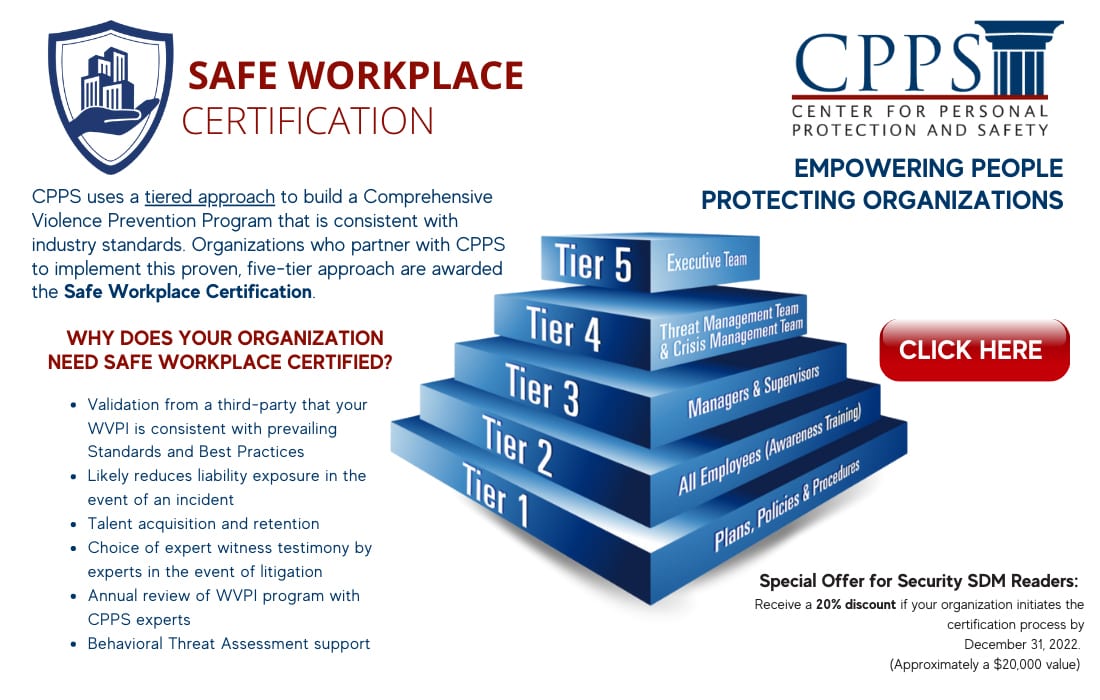august 2022

Integrated Solutions
By John Nemerofsky, Contributing Writer
As Congress debates healthcare workplace violence prevention legislation, security leaders can look to technology to help employees stay safe at work.
Combat Workplace Violence With Security Technology

ozgurdonmaz / E+ via Getty Images
Workplace violence in the United States has reached epidemic proportions. There is no shortage of data that illuminates assaults, or the constant threat of assault, that occur in organizations of all sizes and across all industries.
The extent of the violence against workers is staggering. According to the Occupational Safety and Health Administration (OSHA), each year an average of almost 2 million U.S. employees report having been a victim of violence while on the job. The financial burden from the assaults cannot be ignored either. The Department of Justice puts the estimated annual cost to employers of workplace violence at $121 billion.
These incidents fuel rising apprehension across society, especially involving healthcare providers. Consider that three in five Americans (60%) report being concerned about the safety and security of loved ones in a hospital or medical facility, according to a recent consumer survey from Global Healthcare Exchange (GHX). The widespread unease is not unfounded: OSHA has declared workplace violence a “recognized hazard” for hospitals and related facilities.
According to OSHA, security technology plays an important role in a broader strategic approach to mitigate workplace violence. Where appropriate to the facility, OSHA advocates installing video surveillance, extra lighting and alarm systems and minimizing access by outsiders with ID badges, electronic keys and security guards.
Call to Action for a Strategic Approach
The urgency to act and formally develop a response to the preponderance of assaults is being deliberated in Congress. In the U.S. Senate, the recently reintroduced Workplace Violence Prevention for Health Care and Social Service Workers Act would direct OSHA to issue a standard requiring healthcare and social service employers to implement a comprehensive workplace violence prevention plan. The House version of the bill was approved last year.
“Our nurses, doctors, social services workers and healthcare professionals deserve to work in a safe environment free from violence,” said U.S. Senator Tammy Baldwin (D-WI), who introduced the legislation. “Healthcare workers have faced unprecedented obstacles just to stay healthy and do their jobs through the pandemic, and on top of it all, they have seen senseless violence against them. It is unacceptable, and we must provide basic protections and safety standards to a workforce that serves people during some of their most vulnerable times.”
advertisement
advertisement
The legislation cites generalized technology requirements that include “monitoring systems” and “barrier protection,” along with “systems to identify and flag clients with a history of violence.” Security leaders have many technology options to turn to when looking to prevent workplace violence.
Beyond access control and visitor management systems, some of the most fundamental workplace applications of technology begin with weapons detection, which expedites the passage of people without having to be frisked. These systems allow personnel to identify and confiscate a range of lethal instruments — such as firearms, knives, Tasers and more — before they can be carried into a facility.
Artificial intelligence (AI) is now being applied to weapons detection, with the potential to greatly advance situational awareness. These software platforms can be integrated with an organization’s existing networked camera system and video analytics to detect weapons in real time and accelerate automated threat alerting.
Still, other types of audio analytics are helping alert security personnel to identify aggressive behavior by sensing raised voices. Again, the emphasis is on real-time detection, immediate alerting and quick response to engage and neutralize a potentially lethal incident.
A mobile duress system can also help prevent or diffuse violent acts by involving real-time location systems (RTLS). Pressing the button on a worn device, such as a badge or pendant, allows a staff member to summon help and transmit the precise location to security guards and others. These solutions may include wireless call functionality and help decrease response time if an incident occurs.
And don’t be surprised when security robots start patrolling the hallways of healthcare facilities, among other commercial, industrial and campus settings. Increasingly, these autonomous devices are being deployed to serve as a force multiplier for security departments. They can pack an array of capabilities, with 360-degree HD video streaming, thermal cameras, two-way audio communication, automated messaging, object avoidance, smart navigation and more.
The necessity to enhance worker safety is plain, if not an organization’s obligation. Investment in security technology is a natural piece to a comprehensive workplace violence prevention plan.

About the Author
John Nemerofsky is Chief Operating Officer for Kent, Ohio-based Sage Integration. Image courtesy of Nemerofsky
august 2022 / SECURITYMAGAZINE.COM


